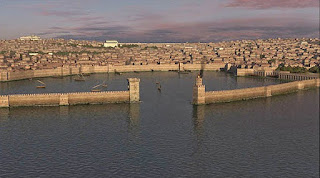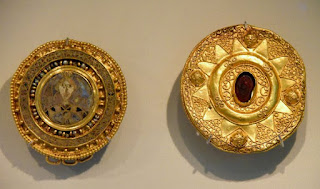Jewellery from Princely Kiev and Byzantine Influence
A study by Ljudmila Pekarska (British Museum):
Kiev, one of the most ancient cities of Europe, was for three centuries the capital of the powerful East Slavonic state of Kievan Rus’ (10th–13th centuries). Prince Vladimir the Great, ruler of Kievan Rus’ (r. 980–1015) introduced Christianity to Rus’ from Byzantium, making it the new state religion in 988. The event marked the beginning of a new era in art for Rus’ in general and for Kiev in particular, which accessed and absorbed the rich culture of the Byzantine Empire. Strategically located on the steep banks of the river Dnieper, Kiev became the focal point of contact between Rus’ and the Byzantine Empire. Kievan Rus’ was very active in adopting everything it needed to become a prosperous state. It developed quickly following the construction of the first Rus’ Christian stone church – richly decorated with marble, mosaics and frescos – built by Byzantine architects and builders in the 10th century in a courtyard in the centre of Kiev.
-->
In the wealthiest and most influential parts of the city, where there was a high concentration of very rich members of princely families, marvellous palaces, stone churches and monasteries were erected surrounded by the building complexes and courtyards of nobles, warriors, administrators, merchants and craftsmen. Local architects, painters and goldsmiths prospered there. In the course of a century Kiev developed into one of the largest international centres in Europe and some Western prelates in the 11th century described Kiev as being ‘the rival of Constantinople’. Chronicles glorified Kiev as ‘the charm of the world’ and ‘the mother of all cities of Rus’, and wrote ‘Kiev does honour to all the lands of Rus’…, it is the glory of Rus’. Throughout the 11th and 12th centuries, ecclesiastical and cultural contacts between Byzantium and Rus’ continued to flourish. Both architecture and the adornment of churches reflected Byzantine influences and features.
The most expensive form of monumental decoration appeared in the interiors of Kievan churches where rich mosaics and frescos depicted events from the life of Christ. Mystical images of individual saints beautified churches while simultaneously seeming to form an integral part of the congregation. Byzantine influence can also be seen in the miniatures of Kievan Rus’ illuminated manuscripts, the old Chronicles and in a number of other books. Christian objects of Rus’ religious services, such as the magnificent processional crosses, patens, chalices and other sacred vessels further enhanced the rich liturgical tradition of the Church. The Byzantine Empire not only supplied the craftsmen of ancient Rus’ with Christian iconography and objects but the rich goldsmiths’ tradition encouraged the development of techniques such as the enamelled-gold technique.
Read here the rest of the article
Kiev, one of the most ancient cities of Europe, was for three centuries the capital of the powerful East Slavonic state of Kievan Rus’ (10th–13th centuries). Prince Vladimir the Great, ruler of Kievan Rus’ (r. 980–1015) introduced Christianity to Rus’ from Byzantium, making it the new state religion in 988. The event marked the beginning of a new era in art for Rus’ in general and for Kiev in particular, which accessed and absorbed the rich culture of the Byzantine Empire. Strategically located on the steep banks of the river Dnieper, Kiev became the focal point of contact between Rus’ and the Byzantine Empire. Kievan Rus’ was very active in adopting everything it needed to become a prosperous state. It developed quickly following the construction of the first Rus’ Christian stone church – richly decorated with marble, mosaics and frescos – built by Byzantine architects and builders in the 10th century in a courtyard in the centre of Kiev.
-->
In the wealthiest and most influential parts of the city, where there was a high concentration of very rich members of princely families, marvellous palaces, stone churches and monasteries were erected surrounded by the building complexes and courtyards of nobles, warriors, administrators, merchants and craftsmen. Local architects, painters and goldsmiths prospered there. In the course of a century Kiev developed into one of the largest international centres in Europe and some Western prelates in the 11th century described Kiev as being ‘the rival of Constantinople’. Chronicles glorified Kiev as ‘the charm of the world’ and ‘the mother of all cities of Rus’, and wrote ‘Kiev does honour to all the lands of Rus’…, it is the glory of Rus’. Throughout the 11th and 12th centuries, ecclesiastical and cultural contacts between Byzantium and Rus’ continued to flourish. Both architecture and the adornment of churches reflected Byzantine influences and features.
The most expensive form of monumental decoration appeared in the interiors of Kievan churches where rich mosaics and frescos depicted events from the life of Christ. Mystical images of individual saints beautified churches while simultaneously seeming to form an integral part of the congregation. Byzantine influence can also be seen in the miniatures of Kievan Rus’ illuminated manuscripts, the old Chronicles and in a number of other books. Christian objects of Rus’ religious services, such as the magnificent processional crosses, patens, chalices and other sacred vessels further enhanced the rich liturgical tradition of the Church. The Byzantine Empire not only supplied the craftsmen of ancient Rus’ with Christian iconography and objects but the rich goldsmiths’ tradition encouraged the development of techniques such as the enamelled-gold technique.
Read here the rest of the article



Comments
Post a Comment